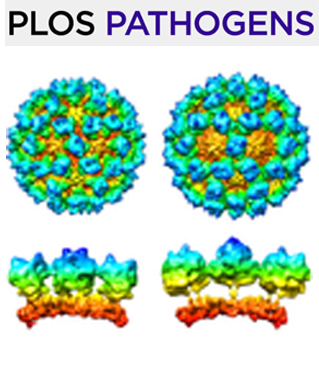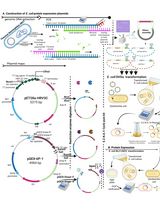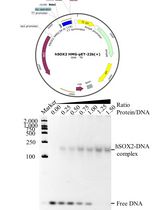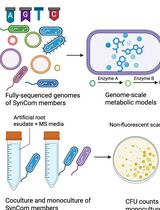- EN - English
- CN - 中文
Purification of the Bacterial Amyloid “Curli” from Salmonella enterica Serovar Typhimurium and Detection of Curli from Infected Host Tissues
从沙门氏菌鼠伤寒血清中纯化细菌淀粉样蛋白“Curli”并检测受感染宿主组织中的 Curli
发布: 2022年05月20日第12卷第10期 DOI: 10.21769/BioProtoc.4419 浏览次数: 3130
评审: Andrea PuharAlberto J. Martin-RodriguezAnonymous reviewer(s)
Abstract
Microbiologists are learning to appreciate the importance of “functional amyloids” that are produced by numerous bacterial species and have impacts beyond the microbial world. These structures are used by bacteria to link together, presumably to increase survival, protect against harsh conditions, and perhaps to influence cell-cell communication. Bacterial functional amyloids are also beginning to be appreciated in the context of host-pathogen interactions, where there is evidence that they can trigger the innate immune system and are recognized as non-self-molecular patterns. The characteristic three-dimensional fold of amyloids renders them similar across the bacterial kingdom and into the eukaryotic world, where amyloid proteins can be undesirable and have pathological consequences. The bacterial protein curli, produced by pathogenic Salmonella enterica and Escherichia coli strains, was one of the first functional amyloids discovered. Curli have since been well characterized in terms of function, and we are just starting to scratch the surface about their potential impact on eukaryotic hosts. In this manuscript, we present step-by-step protocols with pictures showing how to purify these bacterial surface structures. We have described the purification process from S. enterica, acknowledging that the same method can be applied to E. coli. In addition, we describe methods for detection of curli within animal tissues (i.e., GI tract) and discuss purifying curli intermediates in a S. enterica msbB mutant strain as they are more cytotoxic than mature curli fibrils. Some of these methods were first described elsewhere, but we wanted to assemble them together in more detail to make it easier for researchers who want to purify curli for use in biological experiments. Our aim is to provide methods that are useful for specialists and non-specialists as bacterial amyloids become of increasing importance.
Keywords: Curli (Curli)Background
The bacterial cell surface appendages termed curli were first discovered in an E. coli strain that was isolated from horse manure. The authors named the surface structures “curli” because of their curved appearance (Olsén et al., 1989). At nearly the same time, similar surface structures were observed in Salmonella enterica serovar Enteritidis, where they were termed thin aggregative fimbriae (Collinson et al., 1991). The curli and thin aggregative fimbriae had many unique properties, including a requirement for treatment with 90% formic acid (FA) to break the fibers apart into monomeric proteins that could be resolved by SDS-PAGE gel. A landmark study published in 1998 revealed that curli and thin aggregative fimbriae, including the genes required for biosynthesis, were virtually interchangeable between S. enterica and E. coli (Romling et al., 1998). With the publication of the genome sequence of S. Typhimurium LT2, the “curli” nomenclature was chosen for both species. In terms of function, curli are key proteins in the formation of S. enterica and E. coli biofilms, with a primary role in “short-range” cell-cell interactions leading to aggregation (Romling et al., 1998). This aggregation and biofilm formation has been linked to improved persistence and survival in the face of environmental insults (Anriany et al., 2001; Solano et al., 2002; Scher et al., 2005; Ryu and Beuchat, 2005; White et al., 2006). It is quite unique for a surface structure like curli to be conserved between these related, but long diverged species; we have proposed that curli and biofilm formation plays a key role in survival of these enteric bacteria in the environment as they cycle between their hosts. Their conservation throughout S. enterica and E. coli speaks to their importance in the lifecycle of both bacterial species.
Curli are now known to be ‘functional amyloids’. Another landmark paper showed that CsgA, the curli monomer, has self-polymerization properties that are hallmark of amyloids (Chapman et al., 2002). This explained some of the unique, biochemically resistant physical properties of curli that were observed upon their initial purification. The characteristic 3-D structure of amyloids has been termed cross-beta with regular, repeated β-sheets or strands that run perpendicular to the fiber axis. The speculation with curli is that when CsgA monomers are stacked upon each other to form fibers, there is a central non-polar core that would run along the length of curli fibers, leading to extreme stability (Collinson et al., 1999). Assembly of fibers occurs outside of the cell, where unfolded CsgA monomers pass through the outer membrane through the CsgG pore and then snap into their more rigid cross-beta structure (Evans and Chapman, 2014). Although amyloids are notoriously difficult to work with and are not easily amenable to protein crystallography because of the non-uniform fiber-fiber interactions, some structural features have been determined through the use of CsgA-specific peptides (Szulc et al., 2021). Perhaps the most striking analysis performed to date revealed that CsgA “curli” have structural similarity to the amyloid-beta fibrils that are characteristic of Alzheimer’s disease, with both sharing a characteristic structural fold called the steric β-zipper (Perov et al., 2019).
The role of curli in host-pathogen interactions has recently been clarified. Several early studies described curli in the context of host expression (Bian et al., 2000; Olsén et al., 1998; Sjobring et al., 1994), but for a long period, we thought them to be purely an “environmental” factor. Pioneering work by Çagla Tükel, Andreas Baumler, and colleagues identified purified curli fibers as potent stimulators of the innate immune system, where they interact with Toll-like receptor 2 (TLR-2) (Tükel et al., 2005), TLR1/2 and TLR1/2/9 due to the presence of extracellular DNA in complex with curli (Tükel et al., 2010; Tursi and Tükel, 2018). Systemic presentation of curli had a profound impact on autoimmunity in host species, leading to increased presence of circulating anti-dsDNA antibodies, stimulation of nod-like receptors (i.e., NLRP3), and the inflammasome (Gallo et al., 2015; Rapsinski et al., 2015). Most recently, we showed that curli are expressed by S. enterica after oral infection of mice, inside the large intestine, in both acute and long-term infection models (Miller et al., 2020). In these experiments, production of curli by S. enterica cells inside the host led to increased levels of autoimmunity and early signatures of arthritis in the knee joints of infected mice. The impact of curli was tied to the ability of S. enterica to invade host cell epithelium and cause inflammation, indicating that curli must access the lymphoid tissues surrounding the intestine to have negative effects. Many aspects of curli expression in vivo still need to be clarified.
In this manuscript, we present a series of step-by-step protocols with pictures showing how to purify these important bacterial surface structures.
Materials and Reagents
Disposable Culture Tubes 16 × 100 mm (Fisherbrand, catalog number: 14-961-29)
DifcoTM Luria-Bertani broth (BD Biosciences, catalog number: 244620)
Polystyrene disposable Petri dishes 150 mm × 15 mm (VMR International, catalog number: 25384-326).
Cotton tipped applicator, 6 inch (Puritan, catalog number: 1495992B)
Precleaned Microscope Slides (Fisherbrand, catalog number: 12-550-343)
2 mL Safe Lock Tubes (Eppendorf, catalog number: 054027)
5 mm stainless steel bead (Qiagen, catalog number: 69989)
30 mL Oak Ridge round-bottom tubes (Thermo Scientific Nalgene, catalog number: 3115-0030)
Disposable 5ml syringe (BD Biosciences, catalog number: 309647)
Precision Glide Needle (BD Biosciences, catalog number: B305196)
0.22 µm Nitrocellulose membrane (FroggaBio, catalog number: TM300)
Filter paper (Bio-Rad, catalog number: 1703965)
1 ply Kimwipes 11 × 21 cm (KimTech Science Brand, Kimberly-Clark, Code: 34155)
BactoTM Tryptone (BD Biosciences, catalog number: 211705)
DifcoTM Agar, Bacteriological (BD Biosciences, catalog number: 214530)
Tris-HCl pH 8 (Invitrogen, catalog number: 15-568-025)
Dimethyl sulfoxide (DMSO, Sigma-Aldrich, catalog number: D-1435, CAS number: 67-68-5)
Trizma base (Sigma-Aldrich, CAS number: 77-86-1)
Hydrochloric Acid (Bio Basic Canada Inc. CAS number: 7647-01-0)
RNase A, Protease-Free, Highly Purified, Bovine Pancreas (Sigma-Aldrich, CAS number: 9001-99-4)
Deoxyribonuclease I from Bovine Pancreas (Sigma-Aldrich, CAS number: 9003-98-9)
MgCl2·6H2O (Bio Basic Canada Inc. CAS number: 7791-18-6)
Lysozyme from Chicken Egg White (Sigma-Aldrich, CAS number: 12650-88-3)
Sodium dodecyl sulfate (Bio Basic Canada Inc. catalog number: 151-21-3)
40% Acrylamide/Bis Solution 29:1 (Fisher Bioreagents, catalog number: BP1408-1)
Ammonium persulfate (Sigma-Aldrich, CAS number: 7727-54-0)
TEMED (Thermo Scientific, catalog number: 17919)
Sterile distilled water
β- mercaptoethanol (Sigma-Aldrich, LOT number: SHBJ8714; catalog number M6250)
Ethyl Alcohol 95% Vol (Commercial Alcohols by Greenfield Global, Item number: P016EA95)
Glycine (Bio Basic Canada Inc. catalog number: 56-40-6)
BLUelf Prestained Protein Ladder (FroggaBio, catalog number: PM008-0500)
Glycerol (Bio Basic, GB0232, CAS number: 56-81-5)
Bromophenol Blue (Sigma-Aldrich, CAS number: 34725-61-6)
NaCl (Bio Basic, DB0483, CAS number: 7647-14-5)
Tween 20 (Sigma-Aldrich, CAS number: 9005-64-5)
Methanol (Fisher Bioreagents, catalog no: BP1105-4)
IRDye 680RD goat anti-rabbit IgG (Mandel Scientific, ERP No: LIC-926-68071)
Nitro-BT (NBT) (Fisher BioReagentsTM, CAS number: 298-83-9)
5-Bromo-4-chloro-3-indolyl phosphate (BCIP) (Fisher BioReagentsTM, CAS number: 298-83-9)
Formic Acid 98-100% (Millipore Sigma, CAS number: 64-18-6)
1,1,1,3,3,3-Hexafluoro-2-propanol; Hexafluoroisopropanol (HFIP) (Sigma-Aldrich, CAS number: 920-6611)
InvitrogenTM NovexTM WedgeWellTM 4 to 20%, Tris-Glycine, 1.0 mm, Mini Protein Gel, 10-well (Thermo Fisher Scientific, catalog number: XP04200PK2)
InvitrogenTM iBlotTM 2 Transfer Stacks, nitrocellulose, mini (Thermo Fisher Scientific, catalog number: IB23002)
Infected tissue samples
N-cetyl-N,N,N,-trimethyl ammonium bromide (CTAB) (Sigma-Aldrich, CAS number: 57-09-0)
Phenol/chloroform/isoamyl alcohol (pH 7.7–8.3) (49.5:49.5:1) (Sigma-Aldrich, catalog number 77618)
Chloroform (Sigma-Aldrich, CAS number: 67-66-3)
MSB broth (see Recipes)
YESCA broth (see Recipes)
T agar (see Recipes)
2× SDS-PAGE sample buffer (100 mL) (see Recipes)
10× SDS-PAGE running buffer (1,000 mL) (see Recipes)
10× Towbin buffer or Transfer buffer (1,000 mL) (see Recipes)
10× TBS (1,000 mL) (see Recipes)
1× TBST (see Recipes)
12% separating gel (2 gels) (see Recipes)
5% stacking gel (2 gels) (see Recipes)
AP buffer (Alkaline Phosphatase) (500 mL) (see Recipes)
NBT/BCIP developing solution (see Recipes)
Equipment
Water bath
Autoclave vacuum steam sterilizer (GETINGE, model: 533LS)
Biological Safety Cabinet (Therma Electron Corporation, model: 1284)
Water Jacketed CO2 Incubator (Therma Electron Corporation, model: 3110)
Sonicator (BRANSON, DIGITAL SONIFIER 450)
Tissue Homogenizer (Retsch, high-speed mixer mill MM400)
Superspeed Centrifuge (Thermo Scientific, SORVALL EVOLUTION RC)
SDS-PAGE gel big apparatus (Bio-Rad, PROTEAN II xi Cell, model: 1651814)
InvitrogenTM Mini Gel Tank (Thermo Fisher Scientific, model: A25977)
Lyophilizer (FTS SystemTM, Duro-DryTM MP, model: FD2085C0000)
Freezer (Panasonic, SANYO, model: MDF-U76VC)
Weighing balance (METTLER TOLEDO, model: B2002-S)
Trans-Blot SD semi-dry transfer cell (Bio-Rad Laboratories)
InvitrogenTM iBlotTM 2 Gel Transfer Device (Thermo Fisher Scientific, model: IB21001)
Odyssey CLx imaging system and Image Studio 4.0 software package (Li-Cor Biosciences, model: 9140)
DeNovix DS-11 FX Microvolume spectrophotometer/fluorometer
Procedure
文章信息
版权信息
© 2022 The Authors; exclusive licensee Bio-protocol LLC.
如何引用
Sivaranjani, M., Hansen, E. G., Perera, S. R., Flores, P. A., Tukel, C. and White, A. P. (2022). Purification of the Bacterial Amyloid “Curli” from Salmonella enterica Serovar Typhimurium and Detection of Curli from Infected Host Tissues. Bio-protocol 12(10): e4419. DOI: 10.21769/BioProtoc.4419.
分类
微生物学 > 微生物-宿主相互作用 > 细菌
微生物学 > 微生物生物膜 > 生物膜培养
生物化学 > 蛋白质 > 分离和纯化
您对这篇实验方法有问题吗?
在此处发布您的问题,我们将邀请本文作者来回答。同时,我们会将您的问题发布到Bio-protocol Exchange,以便寻求社区成员的帮助。
Share
Bluesky
X
Copy link













